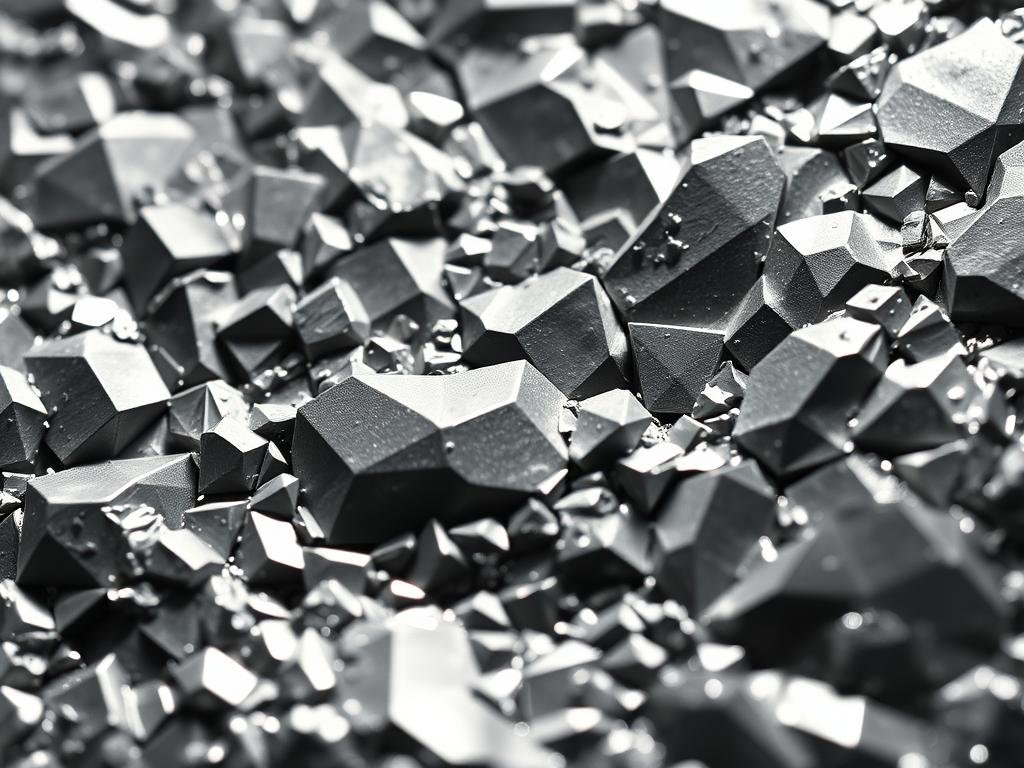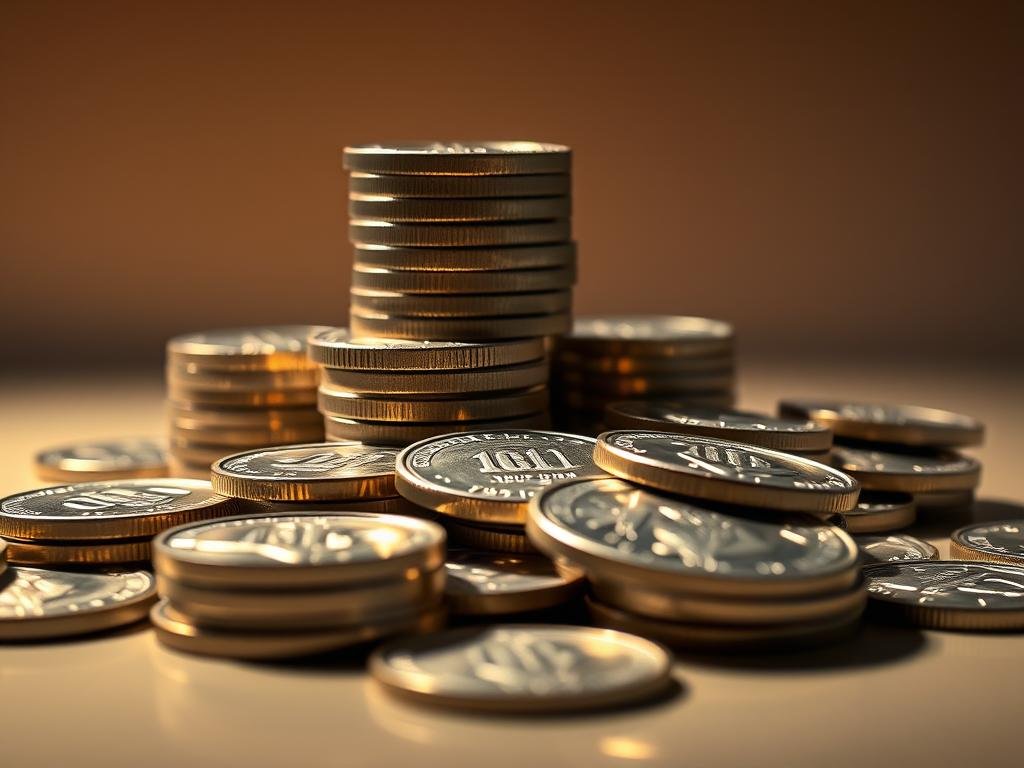الفضة واحدة من أكثر المعادن تنوعًا قيمة المعادن الثمينة في العالم، مع فريد من نوعه الكثافة يلعب دورًا حاسمًا في تحديد قيمته وتطبيقاته.
ال كثافة الفضة يبلغ 10.49 جرام لكل سنتيمتر مكعب (جم/سم³)، وهو مرتفع نسبياً مقارنة بالمعادن الشائعة مثل النحاس والنيكل ولكنه أقل من الذهب.
فهم الخصائص الفيزيائية للمعادن الثمينة مثل الفضة ضروري للمستثمرين، والجامعين، والمستخدمين الصناعيين. يوفر رؤى حول أصالة المعدن، ونقائه، والتطبيقات المحتملة، مما يجعله جانبًا حيويًا في تقييمه الوزن و كتلة.
سيستكشف هذا الدليل الشامل كيف يؤثر كثافة الفضة على قيمتها السوقية وفائدتها الصناعية، مقارنةً مع معادن أخرى وفحص العوامل التي تؤثر على كثافتها.
فهم كثافة الفضة
فهم كثافة الفضة أمر حاسم لتقدير قيمتها وأصالتها. الكثافة هي خاصية فيزيائية أساسية يمكن أن تكشف الكثير عن تركيب المادة وخصائصها.
ما هو الكثافة وكيف يتم قياسها؟
الكثافة تُعرف بأنها الكتلة لكل وحدة حجم لمادة ما. عادةً ما تُقاس بالجرام لكل سنتيمتر مكعب (جم/سم³). لقياس الكثافة، يجب معرفة الكتلة والحجم للشيء.
كثافة الفضة: 10.49 جرام لكل سنتيمتر مكعب
الفضة النقية لها كثافة تبلغ 10.49 جرام لكل سنتيمتر مكعب. هذه القيمة ناتجة عن التركيب الذري للفضة وشبكة البلورة المكعبة ذات المركز الوجه. كثافة الفضة أعلى من المعادن الشائعة مثل النحاس ولكنها أقل من الذهب.
- كثافة الفضة النقية هي بالضبط 10.49 جم/سم³، مما يجعلها أكثر كثافة من العديد من المعادن.
- مكعب بحجم 1 سم³ من الفضة النقية يزن بالضبط 10.49 جرامات.
- الكثافة الثابتة للفضة توفر معيارًا موثوقًا للتحقق من أصالتها.
كثافة الفضة مقارنة مع المعادن الأخرى
فهم كيفية مقارنة كثافة الفضة مع المعادن الأخرى أمر حاسم للمستثمرين والمهتمين على حد سواء. كثافة الفضة هي 10.49 جرام لكل سنتيمتر مكعب، وهو اختلاف كبير عن المعادن الأخرى.
كيف يقارن الفضة بالمعادن الشائعة
When comparing silver to common metals, its density is higher than aluminum (2.7 g/cm³) and copper (8.96 g/cm³) but lower than lead (11.34 g/cm³). This comparison is essential for understanding the physical properties of silver in various applications.
فضة مقابل المعادن الثمينة الأخرى
Among precious metals, silver occupies a middle position in terms of density. Gold has a density of 19.32 g/cm³, and platinum has a density of 21.45 g/cm³, making them significantly denser than silver. On the other hand, palladium, with a density of 12.02 g/cm³, is only slightly denser than silver. The substantial density difference between silver and gold (nearly 2:1) has historically made gold more convenient for high-value transactions in smaller physical packages.
The density difference explains why a one-ounce gold coin is noticeably smaller than a one-ounce silver coin, despite containing the same mass of metal. For investors, understanding these density relationships helps explain the physical differences between precious metal products of equal weight but different compositions.
العوامل التي تؤثر على كثافة الفضة
Understanding the factors that affect silver’s density is crucial for various applications, from industrial manufacturing to investment-grade products.
Temperature Effects on Silver Density
Temperature significantly impacts silver’s density. As temperature increases, silver expands, reducing its density. Conversely, decreasing temperatures cause silver to contract, increasing its density.
Purity and Its Impact on Density
The purity of silver also affects its density. Pure silver has a density of 10.49 g/cm³, but the presence of impurities or alloying elements can alter this value. For instance, sterling silver, which is 92.5% silver, has a slightly different density due to the presence of other metals.
Pressure and Structural Changes
External pressure can significantly affect silver’s density. Under high pressure, the atoms are packed more closely, increasing density. For example, under extreme pressure, silver’s density can increase.
| عامل | Effect on Density |
|---|---|
| ارتفاع درجة الحرارة | Decreases Density |
| Purity | Impacts Density Based on Impurities |
| زيادة الضغط | Increases Density |

Silver Alloys and Their Densities
Silver alloys are mixtures of silver with other metals, designed to enhance its properties for various applications. These alloys are crucial in industries where pure silver’s properties need to be modified to suit specific requirements.
Sterling Silver: Composition and Density
Sterling silver, a popular silver alloy, contains 92.5% silver and 7.5% other metals, usually copper. This composition gives sterling silver a density of approximately 10.3 g/cm³, making it more durable than pure silver while retaining much of its desirable properties.
Other Common Silver Alloys
Beyond sterling silver, other alloys exist with varying densities. For instance, coin silver, with 90% silver and 10% copper, has a density of about 10.31 g/cm³. Britannia silver, containing 95.8% silver, has a density closer to pure silver at approximately 10.42 g/cm³. Modern alloys like Argentium silver offer improved tarnish resistance and maintain a similar density to sterling silver.
How Density Determines Silver Authenticity
The authenticity of silver is often verified by its density, a crucial factor in distinguishing genuine silver from counterfeit products. Density testing is a reliable method for identifying counterfeit silver because it exploits the significant differences in density between silver and common base metals used in counterfeits.
طرق اختبار الكثافة للفضة
اختبار الكثافة يتضمن قياس وزن وحجم قطعة فضة لحساب كثافتها. يمكن القيام بذلك باستخدام أدوات بسيطة مثل ميزان وأنبوب مدرج أو معدات أكثر تطورًا مثل مقاييس هيدروستاتيكية. من خلال مقارنة الكثافة المحسوبة بكثافة الفضة المعروفة (10.49 جم/سم³)، يمكن التحقق من أصالتها.
Identifying Counterfeit Silver Through Density
المنتجات الفضية المقلدة غالبًا ما تستخدم معادن مثل الزنك (7.14 جم/سم³)، القصدير (7.31 جم/سم³)، أو الرصاص (11.34 جم/سم³)، والتي لها كثافات تختلف بشكل كبير عن كثافة الفضة الأصلية. حتى النسخ المقلدة المتقنة التي تحتوي على طلاء فضي فوق نواة معدنية أساسية يمكن اكتشافها من خلال اختبار الكثافة، حيث أن الكثافة الإجمالية لن تتطابق مع كثافة الفضة الصلبة.
| معدن | الكثافة (جم/سم³) |
|---|---|
| فضة | 10.49 |
| الزنك | 7.14 |
| Tin | 7.31 |
| القيادة | 11.34 |
By understanding how to perform basic density tests, collectors and investors can protect themselves against counterfeit silver products. The relationship between an object’s weight and volume provides a mathematical signature that’s difficult to falsify without using genuine silver.
Silver Coins and Bullion: Density Considerations
Silver coins and bullion are popular investment options, with their density being a key factor in their authenticity and value. The density of silver, at 10.49 grams per cubic centimeter, remains consistent across various products.
Popular Silver Coins and Their Specifications
Popular silver coins, such as the American Silver Eagle and Canadian Silver Maple Leaf, adhere to strict minting standards, ensuring their density matches that of pure silver. These coins are typically minted with a high purity level, guaranteeing their density is very close to 10.49 grams per cubic centimeter.
- نسر الفضة الأمريكي: فضة نقية بنسبة 0.999
- Canadian Silver Maple Leaf: .9999 fine silver
قضبان فضة ومنتجات عالية الجودة للاستثمار
Silver bars, ranging from 1-ounce to 1000-ounce sizes, maintain the standard density of silver. The Good Delivery standard for silver bars, established by the London Bullion Market Association, specifies a minimum purity of 99.9% silver, ensuring consistent density. Reputable refiners like PAMP Suisse and Johnson Matthey maintain precise density specifications.

Industrial Applications Leveraging Silver’s Density
Silver’s density plays a crucial role in various industrial applications, enhancing performance and durability across multiple sectors.
Electronics and Electrical Components
Silver is extensively used in electronics due to its high conductivity and durability. In photovoltaic cells, silver’s density and conductivity properties are utilized to create durable electrical contacts that maintain performance over decades.
- Silver’s high conductivity makes it ideal for electrical components.
- Its durability ensures longevity in demanding applications.
Renewable Energy and Medical Applications
In renewable energy, silver’s density supports consistent performance in solar cells. Medical devices also benefit from silver’s unique combination of density, antimicrobial properties, and biocompatibility.
- Silver is used in water purification systems for its antimicrobial properties.
- بطاريات وتقنيات تخزين الطاقة تدمج الفضة لما لها من كثافة وموصلية.
The Relationship Between Silver Density and Value
Understanding the relationship between silver density and its value is essential for investors. The density of silver, at 10.49 grams per cubic centimeter, serves as a fundamental property that can significantly impact its market value.
How Density Affects Market Pricing
The density of silver influences its market pricing by serving as a benchmark for authenticity and purity. Investors often rely on density measurements to verify the quality of silver products, thereby affecting their willingness to pay a premium for high-quality items.
Density as a Quality Indicator for Investors
للمستثمرين الجادين، الكثافة المستمرة للفضة تعتبر مؤشر جودة أساسي. منتجات الفضة ذات الجودة الاستثمارية تلتزم بمواصفات كثافة صارمة، مما يوفر تقييمًا قابلًا للقياس للنقاء يساعد المستثمرين على اتخاذ قرارات مستنيرة.
كما أشار خبراء الصناعة، "العلاقة بين الكثافة المقاسة للمنتج والكثافة النظرية للفضة النقية مهمة جدًا للتحقق من أصالته." فهم هذه الخاصية لا يضمن فقط الثقة في عمليات الشراء، بل يبرز أيضًا موثوقية الفضة كأصل ملموس.
Practical Tips for Measuring Silver Density at Home
باستخدام بعض القياسات البسيطة، يمكنك تحديد كثافة قطع الفضة الخاصة بك وتجنب الأخطاء المكلفة. يتطلب قياس كثافة الفضة حساب وزنها وحجمها.
Simple Tools and Techniques
To measure silver density, you’ll need a precise scale and a way to measure volume, such as water displacement. Ensure the silver object is completely wetted and bubble-free to get accurate results.
الأخطاء الشائعة التي يجب تجنبها
When measuring silver density, avoid common pitfalls such as using imprecise scales or neglecting temperature considerations. Be aware that complex shapes or hollow components can lead to inaccurate volume measurements. Additionally, don’t expect exactly 10.49 g/cm³ for all silver products, as alloys like sterling silver may vary.
- Ensure accurate weight measurements using a precise scale.
- Use water displacement to measure volume, avoiding air bubbles.
- ضع في اعتبارك درجة الحرارة أثناء القياس.
Conclusion: The Significance of Understanding Silver Density
The significance of silver’s density extends far beyond a simple physical property. It is a cornerstone of its value, versatility, and authenticity. With a precise density of 10.49 grams per cubic centimeter, silver’s characteristics make it invaluable in various applications, from coins and jewelry to electronics and renewable energy.
Understanding silver density provides a powerful tool for verifying authenticity and assessing quality. As technology advances, the relationship between silver’s density and its industrial applications continues to evolve, creating new demands for this versatile material. For investors, collectors, and manufacturers, silver’s density remains a constant physical property that grounds its value in measurable reality.
